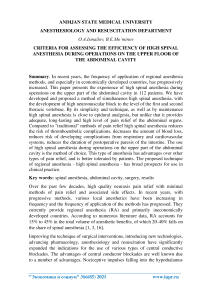Criteria for assessing the efficiency of high spinal anesthesia during operations on the upper floor of the abdominal cavity
Автор: Ismailov O.A., Mominov B.E.
Журнал: Экономика и социум @ekonomika-socium
Рубрика: Основной раздел
Статья в выпуске: 6-1 (85), 2021 года.
Бесплатный доступ
In recent years, the frequency of application of regional anesthesia methods, and especially in economically developed countries, has progressively increased. This paper presents the experience of high spinal anesthesia during operations on the upper part of the abdominal cavity in 112 patients. We have developed and proposed a method of simultaneous high spinal anesthesia, with the development of high neuromuscular block to the level of the first and second thoracic vertebrae. By its simplicity and technique, as well as by maintenance high spinal anesthesia is close to epidural analgesia, but unlike that it provides adequate, long-lasting and high level of pain relief of the abdominal organs. Compared to "traditional" methods of pain relief high spinal anesthesia reduces the risk of thromboembolic complications, decreases the amount of blood loss, reduces risk of developing complications from respiratory and cardiovascular systems, reduces the duration of postoperative paresis of the intestine. The use of high spinal anesthesia during operations on the upper part of the abdominal cavity is the method of choice. This type of anesthesia has advantages over other types of pain relief, and is better tolerated by patients. The proposed technique of regional anesthesia - high spinal anesthesia - has broad prospects for use in clinical practice.
Spinal anesthesia, abdominal cavity, surgery, results
Короткий адрес: https://sciup.org/140260589
IDR: 140260589
Список литературы Criteria for assessing the efficiency of high spinal anesthesia during operations on the upper floor of the abdominal cavity
- Barakh P.D., Cullen B.F., Stalting R.K. Clinical anesthesia. - M .: Medicine, 2007 .-- 300 p. Barakh PD, Kullen BF, Stelting RK. (2007). Clinical anesthesia [Klinicheskaya anesteziya]. Moskva, 300 p.
- Borovskikh N.A., Rosengard S.A. Medical provision of prolonged subarachnoid anesthesia // Mater. interregion. scientific-practical conf. surgeons "Minimally invasive technologies in surgery". - Makhachkala, 2006 .-- S. 61-62. Borovskikh NA, Rosengard SA. (2006). Drug support of the prolonged subarachnoid anesthesia [Medicamentoznoe obespechenie prodlennoy subarakhnoidal'noy anestezii]. Materialy mezhregional'noy nauchno-praktich- eskoy konferentsii khirurgov "Maloinvazivnye tekhnologii v khirurgii". Makhachkala, 61-62.
- Vitenbek I.A., Kovalenko G.A., Isangulova S.G. Adverse reactions and complications of epidural analgesia with local anesthetics and narcotic analgesics // Anesthesiology and resuscitation. - 1987. - No. 5. - S. 62-66. Vitenbek IA, Kovalenko GA, Isangulova SG. (1987). Adverse reactions and complications of epidural local anesthetics and narcotic analgesics [Pobochnye reaktsii i oslozhneniya epidural'noy analgezii mestnymi anesthetics i narkoticheskimi anal'getikami]. Anesteziologiya i reanimatologiya, (5), 62-66.
- Gaikovich A.A. Problems of labor pain relief: bupivacaine or ropivacaine // Tez. report VIII All-Russia. congress of anesthesiologists and resuscitators. - Omsk, 2004 .-- S. 46-47. Gaikovich AA. (2004). Problems of labor analgesia: bupivacaine and ropivacaine [Problemy obezbolivaniya rodov: bupivakain ili ropivakain]. Tezisy dokladov VIII Vse- rossiyskogo sjezda anesteziologov i reanimatologov. Omsk, 46-47.
- Koryachkin V.A., Strashnov V.I. Spinal and epidural anesthesia. - SPb., 2000 .-- 238 p. Koryachkin VA, Strashnov VI. (2000). Spinal and epidural anesthesia [Spinnomozgovaya i epidural'naya anesteziya]. Sankt-Peterburg, 238 p.
- Kuzin M.I., Kharnas S.Sh. Local anesthesia. - M .: Medicine, 1982 .-- 143 p. Kuzin MI, Kharnas SS. (1982). Local anesthesia [Mest noe obezbolivanie]. Moskva, 143 p.
- Nikoda V.V., Bondarenko A.V. Continuous epidural infusion of ropivacaine in the postoperative period // Anesthesiology and Reanimatology. - 2006. - No. 5. - S. 76-79. Nikoda VV, Bondarenko AV. (2006). Continuous epidural infusion of bupivacaine in postoperative peri¬od [Postoyannaya epidural'naya infuziya ropivakaina v posleoperatsionnom periode]. Anesteziologiya ireanima- tologiya, (5), 76-79.
- Ovechkin A.M., Gnezdilov A.V. Naropin (ropivacaine) in pain management: an ideal choice? // Bulletin of intensive care. - 2000. - No. 3. - S. 13-17. Ovechkin AM, Gnezdilov AV. (2000). Naropin (ropiva¬caine) in the treatment of pain: perfect choice? [Naropin (ropivakain) v lechenii boli: ideal'nyy vybor?]. Vestnik intensivnoy terapii, (3), 13-17.
- Method of high spinal anesthesia during operations on the upper floor of the abdominal cavity: Patent 2599044 Ros. Federation; IPC A61M19 00 / Plekhanov A.N., Yakushevsky A.B .; applicant and patentee of the Federal State Budgetary Educational Institution of Higher Professional Education "Buryat State University". - No. 2015134630; declared 08/17/2015; publ. 10.10.2016. Plekhanov AN, Yakushevskiy AB. (2016). Method of high spinal anesthesia in upper abdomen surgeries [Sposob vysokoyspinal'noy anesteziipri operatsiyakh na verkhnem etazhe bryushnoy polosti: Patent2599044Ros. Federatsiya].
- Shtabnitsky A.M. Ropivacaine - an alternative to bupivacaine in obstetrics // Bulletin of intensive therapy. - 2001. - No. 1. - S. 51-54. Shtabnitsky A.M. (2001). Ropivakain - an alternative to bupivacaine in obstetrics [Ropivakain - al'ternativa bupivakainu v akusherstve]. Vestnik intensivnoy terapii, (1), 51-54.
- Shurygin I.A. Spinal anesthesia for caesarean section. - SPb .: Dialect, 2004 .-- 192 p. Shurygin IA. (2004). Spinal anesthesia at cesarean operation [Spinal'naya anesteziya pri kesarevomsechenii]. Sankt-Peterburg, 192 p.
- Alley EA. (2008). Hyperbaric spinal levobupiva- caine: a comparison to racemic bupivacaine in volunteers. Anesth. Analg. 94, 188-193.
- Atanassoff PG, Ocampo CA. (2006) Ropivacaine 0.2% and Lidocaine 0.5% for intravenous regional anes¬thesia in outpatient surgery. Anesthesiology, 95, 627-631.
- Berti M, Casati A, Fanelli G. (2007) Ropivacaine 0.2% with or without fentanyl for patient-controlled epidur¬al analgesia after major abdominal surgery: a double-blind study. Anesthesiol. 12, 292-297.
- Carvalho AC. (2007) Spinal anesthesia with 0.5% hyperbaric ropivacaine and 0.5% hyperbaric bupivacaine: a comparative study. Revista Brasileira de Anestesiologia, 52, 659-665.
- Fritz BA. (2016) Convergent validity of three methods for measuring postoperative complications. Anesthesiol. 12, 89-91.
- Horlocker TT. (2005) Neurologic complication of spinal and epidural anesthesia. Reg. Anest. Pain Med. 25, 83-98.
- Tanaka E. (2016). Lidocaine concentration in oral tissue by the addition of epinephrine. Anesth. Prog., 63, 17-24.


